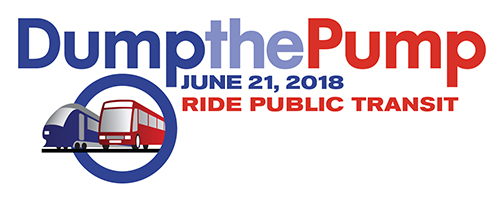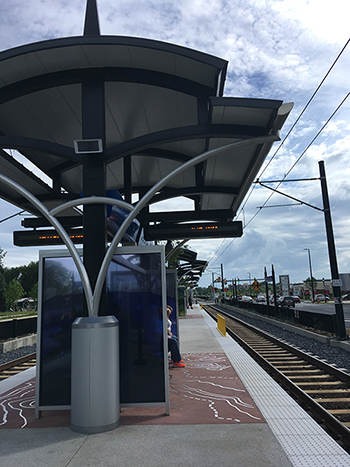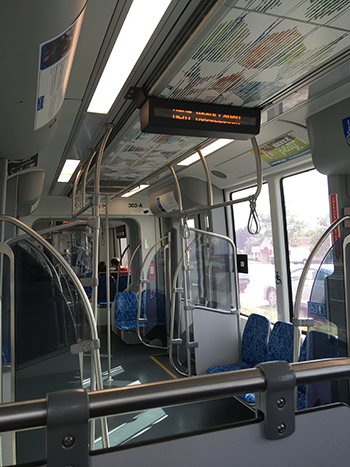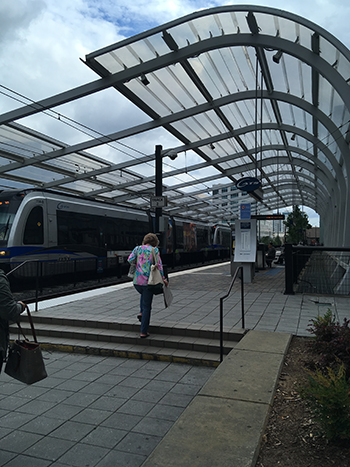No products in the cart.
Mass Transit Celebration on National Dump the Pump Day
On June 21, 2018, the American Public Transportation Association (APTA) and mass transit systems across the country will celebrate the 13th Annual National Dump the Pump Day.
Dump the Pump Day encourages people to ride public transportation as a means of taking them where they need to go, instead of driving a car.
Dump the Pump Day Overview
Started in June 2006, when gas prices were $3 per gallon, this national day emphasizes that mass transit is a convenient travel option that helps people save money and helps communities grow and prosper.

From urban to suburban to rural communities, public transportation is a vital resource to Americans, and a cornerstone of our nation’s economy and local economies. In fact, public transportation helps to make a community economically competitive. Additionally, mass transit provides economic opportunities, since 87% of public transit trips directly impact the economy.
How Mass Transit Plays into Green Building
Everblue was founded on the principles of economic stability and reducing our nation’s dependence on foreign oil. This mission led us to teaching courses on sustainability and green building. Our most popular program teaches architects, engineers, facility managers, and other construction-industry professionals how to design, build, and maintain buildings according to the Leadership in Energy and Environmental Design standards. LEED, for short, is the leading certification program for buildings, homes, communities, and relevant stakeholders that want to demonstrate their environmental and economic advantages achieved through green building strategies.
If you’ve been following the LEED program, then you know that there has been more and more attention given to buildings that are located near amenities and mass transit. One of the common misconceptions about LEED Certification is that it’s just incorporating a few energy-efficient technologies into your building design, but it’s so much more than that. LEED Certification is about creating a healthy, safe, and durable building in addition to it being energy-efficient.
To offer a point of reference, the U.S. Green Building Council, who created the LEED standards, dramatically updated the LEED program in 2014 to what is called LEED Version 4. One of the major components to this update was the “creation” of the Location and Transportation category. Previously, these focus areas were included in the Sustainable Sites category, but with growing awareness on the benefits of public transportation, the USGBC broke those focus areas into their own section.
The Location and Transportation category provides eight opportunities for a building to provide optimum access to quality alternative transportation and to reduce greenhouse gas emissions. The sub-sections in this category are:
- LEED for Neighborhood Development location
- Sensitive land protection
- High priority site
- Surrounding density and diverse uses
- Access to quality transit
- Bicycle facilities
- Reduce parking footprint
- Green vehicles
For more information about each of these strategies, you should consider enrolling in a LEED Green Associate Exam Prep course. This training is designed to take a deep dive into all of the LEED v4 categories so that you can talk confidently about LEED and work on LEED building projects.
Awesome Facts About Public Transportation
Given that June 21 is Dump the Pump Day, I’d like to take a moment to focus on “Access to quality transit.”
Technically, this section is described as having the intent to:
Encourage development in locations shown to have multimodal transportation choices or otherwise reduced motor vehicle use, thereby reducing greenhouse gas emissions, air pollution, and other environmental and public health harms associated with motor vehicle use.
The American Public Transportation Association (APTA) has been kind enough to supply supporting statistics that further show the benefits of mass transit. For example, here’s a snapshot of its awesome facts:
Economic Benefits
- For every $1 invested in public transportation, $4 is returned in economic returns.
- Every $1 billion invested in public transportation supports and creates more than 50,000 jobs.
- Public transportation is a $68 billion industry that employs more than 420,000 people.
- Every $10 million in capital investment in public transportation yields $30 million in increased business sales.
- Home values performed 42% better than when located near high-frequency public transit.
- Hotels in cities with direct rail access to airports raise 11% more revenue per room than hotels in those cities without.
Safety Benefits
- A person can reduce his or her chance of being in an accident by more than 90% simply by taking public transit as opposed to commuting by car.
- Traveling by public transportation is 10 times safer per mile than traveling by automobile.
Money Benefits
- The average household spends 18 cents of every dollar on transportation, and 96% of this goes to buying, maintaining, and operating cars, the largest expenditure after housing.
- A household can save nearly $10,000 by taking public transportation and living with one less car.
Environmental Benefits
- Public transportation use reduces our nation’s dependence on foreign oil by 4.2 billion gallons of gasoline a year.
- It also saves 37 million metric tons of carbon emissions annually.
Personal Benefits
- Millennials consider public transportation as the best option for digital socializing and among the best for connecting with communities.
- Public transportation provides personal mobility and freedom for people from every walk of life.
- Access to public transportation gives people transportation options to get to work, go to school, visit friends, or go to a doctor’s office.
- A total of 87% of trips on public transit have a direct impact on the local economy.
- Of all riders, 71% are employed and 7% are students.
- More than two-thirds of riders walk to their stop or station.
Become an Advocate for Mass Transit
On a more personal note, I just want to share how much I enjoy public transportation. It’s so convenient and reliable and so utterly accessible for so many people.
I rely on mass transit when I go on vacation. Much of my vacation research showed that it was “impossible” to navigate Los Angeles for a week on only public transportation – well I did, and I had no problem. From downtown LA to Hollywood to Santa Monica to Venice Beach to Long Beach, I took buses and light rail for all of my adventures. In recent years, I’ve traversed New York City, Boston, and Los Angeles all through subway, bus, and light rail.
It was only after my most recent trip to LA that I started to consider the possibility of using public transportation in my everyday life. I’ve started to pay more attention to where the bus stops are located near me, and I also found that there are three Park and Ride facilities in my area as well. Now my only difficulty is navigating our local public transportation company’s website to find out the bus schedule! I am adamant about improving this process and getting the word out that public transportation is awesome! I’m super excited that Dump the Pump Day exists, and I hope folks give it a try.
Our local university recently completed its construction on a light rail stop on campus that takes students and riders downtown. A few weeks ago, I chose to take the light rail into the city and geeked out the entire time about how simple and fun it was. Check out my photos below from my experience!

Light Rail Stop
| 
Incoming Light Rail
|

Inside Light Rail
| 
Light Rail Stop Downtown
|